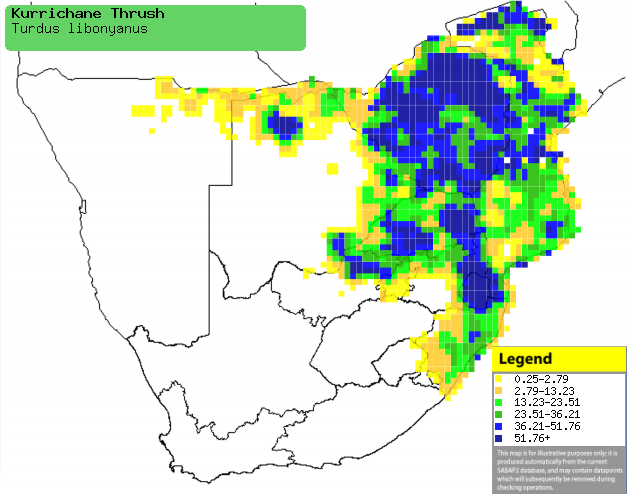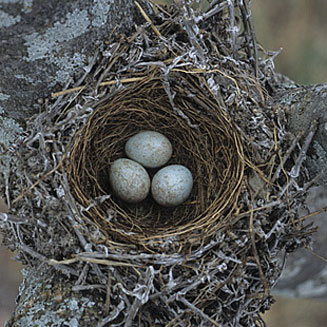|
Turdus libonyanus (Kurrichane thrush)
[=
Turdus libonyana]
Rooibeklyster [Afrikaans]; umuNswi (generic term for
thrush) [Zulu]; Mbyhiyoni [Tsonga]; Kurrichane-lijster [Dutch]; Merle
kurrichane [French]; Rotschnabeldrossel [German]; Tordo-chicharrio
[Portuguese]
Life
> Eukaryotes >
Opisthokonta
> Metazoa (animals) >
Bilateria >
Deuterostomia > Chordata >
Craniata > Vertebrata (vertebrates) > Gnathostomata (jawed
vertebrates) > Teleostomi (teleost fish) > Osteichthyes (bony fish) > Class:
Sarcopterygii (lobe-finned
fish) > Stegocephalia (terrestrial
vertebrates) > Tetrapoda
(four-legged vertebrates) > Reptiliomorpha > Amniota >
Reptilia (reptiles) >
Romeriida > Diapsida > Archosauromorpha > Archosauria >
Dinosauria
(dinosaurs) > Saurischia > Theropoda (bipedal predatory dinosaurs) >
Coelurosauria > Maniraptora > Aves
(birds) > Order: Passeriformes
> Family: Muscicapidae > Genus: Turdus
Distribution and habitat
Occurs in south-central Africa, from Tanzania and southern
DRC through Angola, Zambia and Malawi to southern Africa. Here it is locally
common in a wide variety of habitats, but it generally prefers miombo (Brachystegia),
Acacia (to a lesser extent) and moist woodland. It also occupies
valley bushveld, alien plantations, gardens and parks.
|
 |
|
Distribution of Kurrichane thrush in southern Africa,
based on statistical smoothing of the records from first SA Bird Atlas
Project (©
Animal Demography unit, University of
Cape Town; smoothing by Birgit Erni and Francesca Little). Colours range
from dark blue (most common) through to yellow (least common).
See here for the latest distribution
from the SABAP2. |
Brood parasites
It has been recorded as host of the
Red-chested cuckoo.
Food
It eats a variety of insect and fruit, doing most of its
foraging on the ground, scratching in leaf litter and pecking the soil in search
of food. It has been observed to kleptoparasitise, attempting unsuccessfully to
steal food from a wasp and a
Pearl-spotted owlet. The following food items have been recorded
in its diet:
- Animals
- Plants
- Ficus (figs)
- Rhus berries
Breeding
- The nest (see image below) is a bowl built solely by the female in about
1-2 days, consisting of a foundation of mud mixed with rootlets on which a
cup of grass, twigs and leaves is built, occasionally also with string,
plastic and paper as well. The nest is usually built after rainfall - if
not, all the materials are dipped in water to make them damp. It is
typically placed in the three-pronged fork of a branch near the tree trunk,
or occasionally on a horizontal branch, and it may even use refurbished
nests of other species, such as the
Groundscraper thrush,
Laughing dove and
Common fiscal.
 |
|
|
Kurrichane thrush nest with eggs, Sericea
farm, South Africa. [photo Warwick Tarboton ©] |
|
- Egg-laying season is from August-March, peaking from September-December.
- It lays 1-4 eggs, which are incubated solely by the female for about
12-15 days.
- The chicks are brooded by the female, with both parents feeding their
young on a diet of insects and worms, the size of which increase as the
chicks age. They eventually leave the nest after about 12-16 days, after
which they still remain dependent on their parents for at least 2 more
months. Parental devotion is very strong in this species, as a "lost" chick
adopted by people was observed being fed by a parent through the bars of the
cage days after they were separated.
Threats
Not threatened, in fact it is quite common and has adapted
well to the introduction of man-made habitats.
References
-
Hockey PAR, Dean WRJ and Ryan PG 2005. Roberts
- Birds of southern Africa, VIIth ed. The Trustees of the John Voelcker
Bird Book Fund, Cape Town.
|
